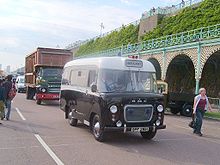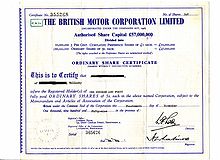British Motor Corporation
The British Motor Corporation (BMC for short) was a vehicle manufacturer in Longbridge, England, which was formed from the merger of the Austin and Nuffield organisations in 1952. At that time, BMC was the largest British vehicle manufacturer with a share of 39 percent and produced a variety of vehicles under the brand names Austin, Morris, MG and Austin-Healey as well as almost unknown brands in German-speaking countries such as Vanden Plas, Riley and Wolseley. One of BMC's best-known passenger cars in Germany was the Mini.
The company's headquarters was Longbridge near Birmingham, where Austin's main plant was also located. In general, Austin was the dominant partner of the group, which was particularly reflected in the corresponding composition of the board of directors.
In the mid-1960s, the company faced a number of problems. Whereas the Austin plant in Longbridge was at the cutting edge of technology and offered sufficiently large capacities with short distances, Nuffield had a total of 16 smaller and often obsolete production facilities scattered throughout central England. In terms of marketing and cost control, however, the opposite was true, with profit margins becoming ever smaller, especially at Austin.
Although the limited financial scope restricted the possibilities for developing new vehicles, most of the models of the 1960s with front-wheel drive, transverse engines, hydrolastic chassis and disc brakes were in part far ahead of their time in purely technical terms. However, the models on offer were increasingly out of step with the tastes of the times and were pitted against much more modern and attractively designed vehicle types from competitors. As a result, market shares declined, especially for the larger and higher-margin volume models such as the Austin 1800. The smaller models such as the Mini and the Austin 1100 continued to sell very well, but the profit margin on these models was low.
The merger of the two companies had created a product portfolio that was in part quite opaque. In some market segments, the models competed with each other, while other segments were only weakly occupied. In addition, the Riley and Wolseley models in particular sold only in small numbers, which made profitable production practically impossible. However, the discontinuation of these two brands was not easily possible due to the high loyalty of their customers in particular, so that badge engineering of some Austin models was used here.
In 1966 BMC, the supplier and coachbuilder Pressed Steel and Jaguar Cars (with Daimler) merged to form British Motor Holdings. In the course of the decline of the British vehicle industry, with sharply falling sales on the domestic market and in the remaining Commonwealth countries, a further merger took place in 1968 with Leyland Motor Corporation (LMC) to form British Leyland Motor Corporation (BLMC).

BMC ambulance (2004)

old British Motor Corp. stock.
Questions and Answers
Q: Who did BMC acquire in September 1965?
A: BMC acquired Pressed Steel, which was also Jaguar's body supplier.
Q: When did BMC merge with Jaguar Cars Limited?
A: BMC merged with Jaguar Cars Limited in September 1966.
Q: What did BMC change its name to in December 1966?
A: BMC changed its name to British Motor Holdings Limited (BMH) on 14 December 1966.
Q: What did Leyland Motor Corporation Limited make?
A: Leyland Motor Corporation Limited made trucks and buses.
Q: What was Standard-Triumph International Limited?
A: Standard-Triumph International Limited was a company that was owned by Leyland Motor Corporation Limited.
Q: When did BMH merge with Leyland Motor Corporation Limited?
A: BMH merged with Leyland Motor Corporation Limited in May 1968.
Q: What did BMH become after merging with Leyland Motor Corporation Limited?
A: After merging with Leyland Motor Corporation Limited, BMH became the major part of British Leyland Motor Corporation.
Search within the encyclopedia